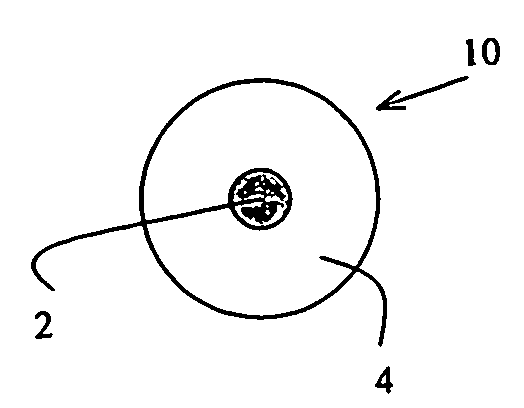Multicomponent fiber including a luminescent colorant
a multi-component, colorant technology, applied in the field of polymeric fibers, can solve the problems of poor adhesion of coating or laminate structure, delaminate or otherwise detach, and limited flexibility of coating or laminated products, so as to reduce colorant loading, increase production time and cost, and reduce colorant loading
- Summary
- Abstract
- Description
- Claims
- Application Information
AI Technical Summary
Benefits of technology
Problems solved by technology
Method used
Image
Examples
example 1
[0066]As a comparative sample, a nylon filament yarn is spun using a uniform blend of phosphorescent pigments in nylon 6 polymer. The pigments comprise 6% of the weight of the blend of pigments in nylon. The yarn is spun with 70 filaments and fully drawn to a total yarn denier of 320. The pigment dispersion is essentially uniform throughout the entire cross section of every filament in the yarn.
[0067]A bicomponent nylon filament yarn of the invention is also spun with a sheath / core cross section. The sheath component comprises nylon 6 and contain no pigment. The core component comprises a uniform blend of the same phosphorescent pigments used in the comparative example above in nylon 6. In this blend, the phosphorescent pigment comprises 30% of the weight of the blend of pigment and nylon 6. The melt pumps for the sheath and core polymers are set to produce a ratio of 80%:20% of the cross sectional area of each fiber occupied by the pigment-free sheath and the pigmented core, respec...
example 2
[0069]A first sample fiber is prepared to include 6% phosphorescent pigment, based on the weight of the fiber, but the pigment is all contained in a core comprising only 20 percent of the cross-sectional area of the fiber. A second fiber sample is prepared as a comparative and also includes 6% phosphorescent pigment. In the second fiber, the pigment is evenly dispersed throughout the entire cross section of the fiber. Both fibers are made with the same nylon 6 polymer using the same spinning and drawing conditions, and both have the same denier per filament.
[0070]Both samples are exposed to the same light source for the same period of time, and the emitted light is measured for each sample. After exposing both samples to the same light source for the same time, the first sample emits an average of 17% more light than the second sample, based on comparative measurements made at multiple points over a 100 minute period. The second comparative sample did not emit more light than the fi...
PUM
| Property | Measurement | Unit |
|---|---|---|
| length | aaaaa | aaaaa |
| total weight | aaaaa | aaaaa |
| polymeric | aaaaa | aaaaa |
Abstract
Description
Claims
Application Information
 Login to View More
Login to View More - R&D
- Intellectual Property
- Life Sciences
- Materials
- Tech Scout
- Unparalleled Data Quality
- Higher Quality Content
- 60% Fewer Hallucinations
Browse by: Latest US Patents, China's latest patents, Technical Efficacy Thesaurus, Application Domain, Technology Topic, Popular Technical Reports.
© 2025 PatSnap. All rights reserved.Legal|Privacy policy|Modern Slavery Act Transparency Statement|Sitemap|About US| Contact US: help@patsnap.com


